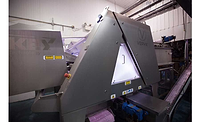Think about dairy, and you likely conjure up familiar grocery staples like milk, cheese and butter. But the proteins found in raw dairy products also serve as key ingredients for a wide range of health and nutrition products.
Milk Specialties Global is a major supplier of these proteins, with 10 manufacturing facilities located throughout the Midwest and in California. The Minnesota-based company processes raw milk and whey into a broad portfolio of ingredients, including milk proteins, whey proteins and specialty proteins.
These ingredients are then shipped to customers that use them in food and beverage products ranging from coffee creamers and baking goods to processed cheeses and Greek yogurts. They are also a primary ingredient in high-demand, sports-nutrition, weight-loss products, such as protein powders, protein shots and meal-replacement bars. And they are used in a variety of animal-nutrition products, including milk replacers, energy boosters and nutritional supplements.
Milk Specialties has rapidly grown in recent years to keep up with market demand. The company of only about 800 employees is today nearing $1 billion in annual revenue. To help meet high demand, the company recently made investments in manufacturing intelligence to achieve real-time analytics and insights into its operations to drive improvements in production processes.
Despite the tremendous variations that can occur in the raw ingredient input streams that the company receives, it still must deliver consistent-quality output streams.
For its human nutrition products, the raw, dairy-product stream is separated with state-of-the-art membrane technologies—which allows the isolated proteins to remain in their native state. From there, the stream is sent through a dryer and finally to the packaging line. Identifying and improving inefficient processes in these operations were challenging. The facilities’ production control systems were data silos, with little ability to track or compare data over time. And the reporting capabilities that were in place were outdated and labor intensive.
For example, tracking the clean-in-place (CIP) chemical usage involved workers downloading data from a machine into a Microsoft Word document and then manually entering that data into a spreadsheet to create a graph. This not only took time, it also restricted workers’ abilities to view data quickly and within multiple contexts to truly understand CIP chemical usage.
When the company inherited a legacy, historian software system with an acquired production facility in Visalia, CA, Mike Calva, corporate programmer and analyst for Milk Specialties Global, saw an opportunity to do more with production data.
“The historian was only being used for compliance,” says Calva. “It basically worked in the background, and we weren’t getting anything out of it from an operations perspective. But we knew the potential was there. We wanted something for production that could help us discover the ‘art of the possible’ in our operations.”
Milk Specialties drew up plans to begin rolling out manufacturing intelligence systems across its three primary human nutrition facilities. These included the Visalia location, as well as facilities in Fond du Lac, WI and Mountain Lake, MN.
The company chose FactoryTalk VantagePoint EMI enterprise manufacturing intelligence software from Rockwell Automation, which can integrate a variety of production and business data into a single information-management, analytics and decision-support system. Within Milk Specialties’ operations, the software collects, correlates and displays real-time process, business and laboratory data.
The system was first implemented at the Fond du Lac facility. In the process of rolling out the EMI software at the Visalia facility, the scope grew as users kept discovering new opportunities for using it.
“An idea for using the software to create in-plant scoreboards came about during the implementation,” Calva says. “Our chief operating officer was the driving force behind that. He wanted everyone on the plant floor to have visibility—to always know if we are winning or losing based on our performance data—and then have the tools to dig into the issue, investigate the root cause of underperformance and fix it.”
At the Visalia facility, tailored scoreboards were placed in three key production areas: separation, filtration and drying. A fourth scoreboard, displaying plant-wide operations, was placed in the facility’s front office.
The scoreboard in each production area displays plant summary data, such as throughput, as well as data relevant to workers in that specific location. For example, workers in the separation area can view the fat volume in the skim stream or the temperature in the pasteurizing process, while workers in the dryer area can view evaporation levels and outputs to the bagging line.
The EMI software has established a decision-making process that is based on data and can be applied to any one of the facilities. For instance, when process engineers at the Fond du Lac facility wanted to add a new mid-wash process to perform an additional flush between batch runs, the new system showed significant yield improvements following the change.
The software also helped resolve an issue with the dryer in the Visalia plant. After reviewing data on the operators’ activities, including seeing down to the level of operators’ sequence of actions, it was learned that operators were not starting up and shutting down the equipment in the right sequence.
For more information:
Rockwell Automation, 414-486-5800,
sales@rockwellautomation.com, www.rockwellautomation.com.





